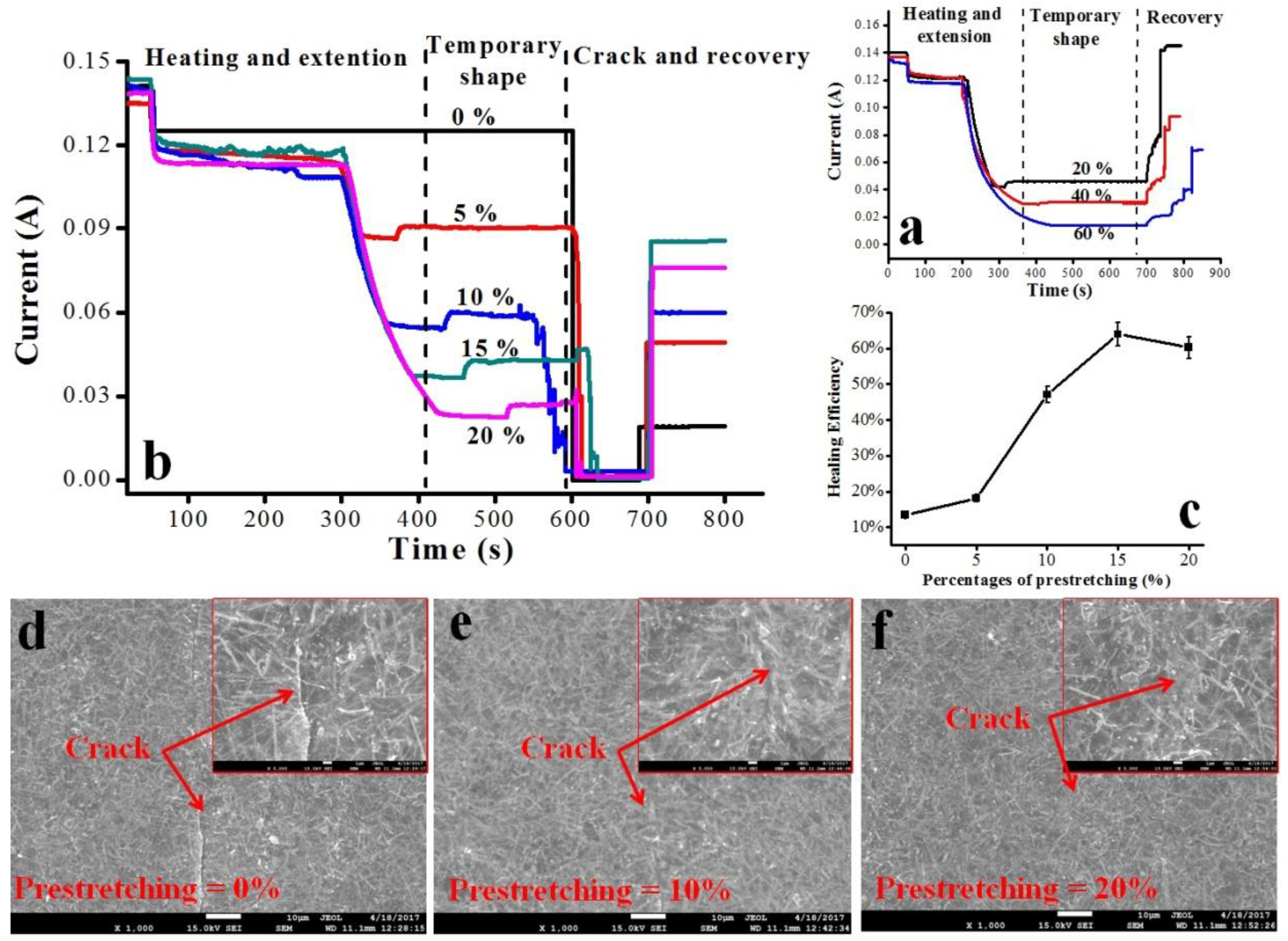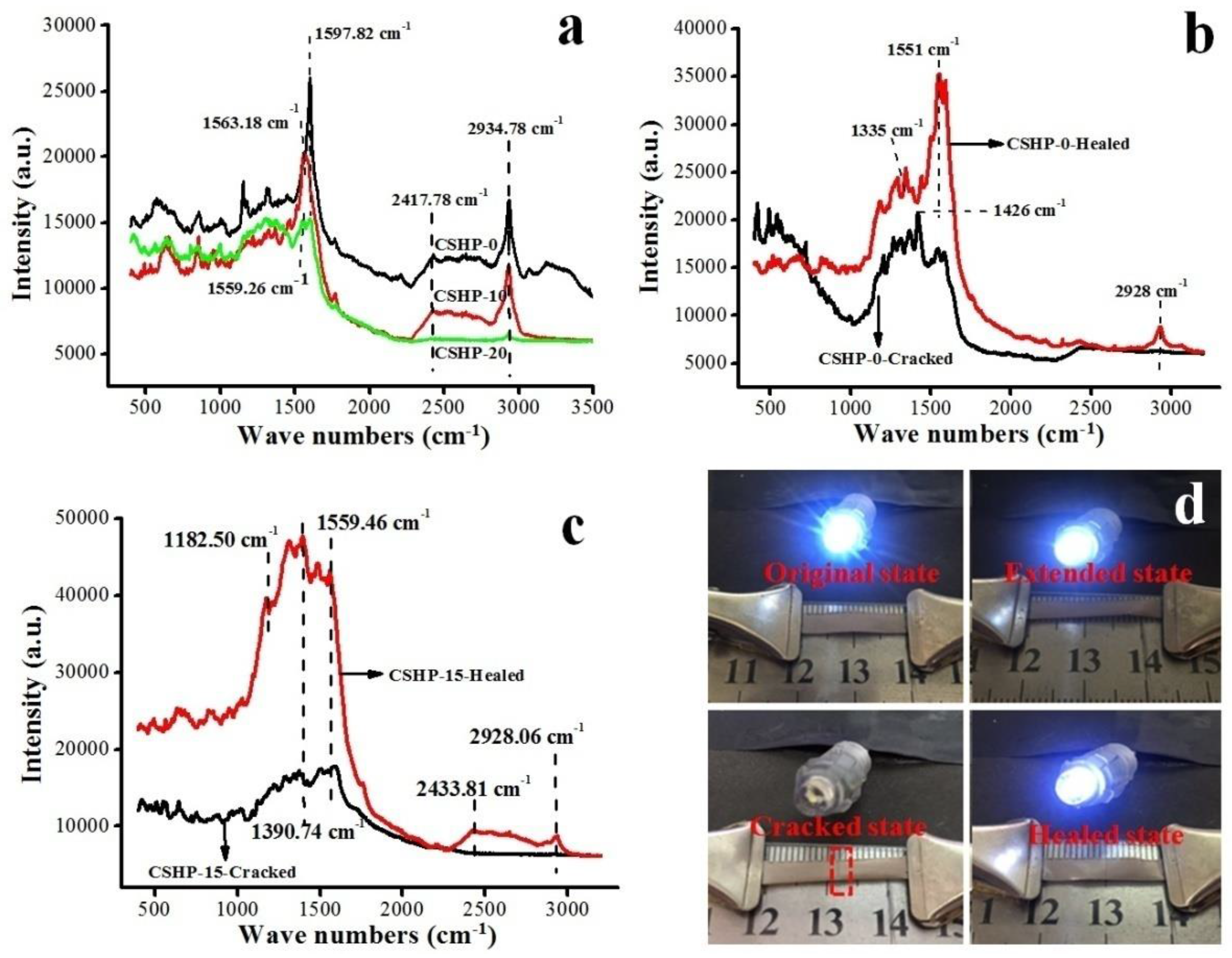Shape Memory-Enhanced Electrical Self-Healing of Stretchable Electrodes
Abstract
:1. Introduction
2. Materials and Methods
3. Results and Discussion
3.1.Fabricationof the Healable Stretchable Electrodes
3.2. Shape Memory-Enhanced Self-Healing with Pre-Stretching
3.3. Raman Spectra Investigations on the Microstructure Evolution
4. Conclusions
Acknowledgments
Author Contributions
Conflicts of Interest
References
- Wang, Z.J.; Tian, H.M.; He, Q.G.; Cai, S.Q. Reprogrammable, Reprocessible, and Self-Healable Liquid Crystal Elastomer with Exchangeable Disulfide Bonds. ACS Appl. Mater. Inter. 2017, 9, 33119–33128. [Google Scholar] [CrossRef] [PubMed]
- Xiao, X.L.; Hu, J.L.; Gui, X.T.; Lu, J.; Luo, H.S. Is biopolymer hair a multi-responsive smart material? Polym. Chem. 2017, 8, 283–294. [Google Scholar] [CrossRef]
- Luo, X.F.; Mather, P.T. Shape Memory Assisted Self-Healing Coating. ACS Macro Lett. 2013, 2, 152–156. [Google Scholar] [CrossRef]
- Chen, W.; Zhou, Y.Y.; Li, Y.; Sun, J.; Pan, X.Q.; Yu, Q.; Zhou, N.C.; Zhang, Z.B.; Zhu, X.L. Shape-memory and self-healing polyurethanes based on cyclic poly(epsilon-caprolactone). Polym. Chem. 2016, 7, 6789–6797. [Google Scholar] [CrossRef]
- Yao, Y.T.; Wang, J.J.; Lu, H.B.; Xu, B.; Fu, Y.Q.; Liu, Y.; Leng, J.S. Thermosetting epoxy resin/thermoplastic system with combined shape memory and self-healing properties. Smart Mater. Struct. 2016, 25, 015021. [Google Scholar] [CrossRef]
- Cai, G.F.; Wang, J.X.; Qian, K.; Chen, J.W.; Li, S.H.; Lee, P.S. Extremely Stretchable Strain Sensors Based on Conductive Self-Healing Dynamic Cross-Links Hydrogels for Human-Motion Detection. Adv. Sci. 2017, 4. [Google Scholar] [CrossRef] [PubMed]
- Cao, J.; Lu, C.H.; Zhuang, J.; Liu, M.X.; Zhang, X.X.; Yu, Y.M.; Tao, Q.C. Multiple Hydrogen Bonding Enables the Self-Healing of Sensors for Human-Machine Interactions. Angew. Chem. Int. Ed. 2017, 56, 8795–8800. [Google Scholar] [CrossRef] [PubMed]
- Li, L.; Shi, P.P.; Hua, L.; An, J.N.; Gong, Y.J.; Chen, R.; Yu, C.Y.; Hua, W.W.; Xiu, F.; Zhou, J.Y.; et al. Design of a wearable and shape-memory fibriform sensor for the detection of multimodal deformation. Nanoscale 2018, 10, 118–123. [Google Scholar] [CrossRef] [PubMed]
- Luo, H.S.; Zhou, X.D.; Xu, Y.C.; Wang, H.Q.; Yao, Y.T.; Yi, G.B.; Hao, Z.F. Multi-Stimuli Triggered Self-Healing of the Conductive Shape Memory Polymer Composites. Pigment Resin Technol. 2018, 47, 1–6. [Google Scholar] [CrossRef]
- Luo, H.S.; Zhou, X.D.; Ma, Y.Y.; Yi, G.B.; Cheng, X.L.; Zhu, Y.; Zu, X.H.; Zhang, N.J.; Huang, B.H.; Yu, L.F. Shape memory-based tunable resistivity of polymer composites. Appl. Surf. Sci. 2016, 363, 59–65. [Google Scholar] [CrossRef]
- Wang, H.Q.; Luo, H.S.; Zhou, X.D.; Lin, Y.L.; Zhao, G.; Yi, G.B.; Cheng, X.L.; Wang, H.; Li, J.D. Conductive multi-shape polymer composites towards stimuli sensing. Mater. Lett. 2017, 198, 132–135. [Google Scholar] [CrossRef]
- Li, G.Q.; Ajisafe, O.; Meng, H. Effect of strain hardening of shape memory polymer fibers on healing efficiency of thermosetting polymer composites. Polymer 2013, 54, 920–928. [Google Scholar] [CrossRef]
- Wang, X.Y.; Zhao, J.; Chen, M.; Ma, L.; Zhao, X.D.; Dang, Z.-M.; Wang, Z.W. Improved Self-Healing of Polyethylene/Carbon Black Nanocomposites by Their Shape Memory Effect. J. Phys. Chem. B 2013, 117, 1467–1474. [Google Scholar] [CrossRef] [PubMed]
- Lu, H.B.; Wang, X.D.; Yu, K.; Huang, W.M.; Yao, Y.T.; Leng, J.S. A phenomenological formulation for the shape/temperature memory effect in amorphous polymers with multi-stress components. Smart Mater. Struct. 2017, 26, 095011. [Google Scholar] [CrossRef]
- Hu, J.L.; Zhu, S.S.; Young, R.J.; Cai, Z.Q.; Li, L.B.; Han, J.P.; Pan, N. Stress memory materials and their fundamental platform. J. Mater. Chem. A 2017, 5, 503–511. [Google Scholar] [CrossRef]
- Narayana, H.; Hu, J.L.; Kumar, B.; Shang, S.M.; Han, J.P.; Liu, P.Q.; Lin, T.; Ji, F.L.; Zhu, Y. Stress-memory polymeric filaments for advanced compression therapy. J. Mater. Chem. B 2017, 5, 1905–1916. [Google Scholar] [CrossRef]



© 2018 by the authors. Licensee MDPI, Basel, Switzerland. This article is an open access article distributed under the terms and conditions of the Creative Commons Attribution (CC BY) license (http://creativecommons.org/licenses/by/4.0/).
Share and Cite
Luo, H.; Wang, H.; Zhou, H.; Zhou, X.; Hu, J.; Yi, G.; Hao, Z.; Lin, W. Shape Memory-Enhanced Electrical Self-Healing of Stretchable Electrodes. Appl. Sci. 2018, 8, 392. https://doi.org/10.3390/app8030392
Luo H, Wang H, Zhou H, Zhou X, Hu J, Yi G, Hao Z, Lin W. Shape Memory-Enhanced Electrical Self-Healing of Stretchable Electrodes. Applied Sciences. 2018; 8(3):392. https://doi.org/10.3390/app8030392
Chicago/Turabian StyleLuo, Hongsheng, Huaquan Wang, Huankai Zhou, Xingdong Zhou, Jinlian Hu, Guobin Yi, Zhifeng Hao, and Wenjing Lin. 2018. "Shape Memory-Enhanced Electrical Self-Healing of Stretchable Electrodes" Applied Sciences 8, no. 3: 392. https://doi.org/10.3390/app8030392




